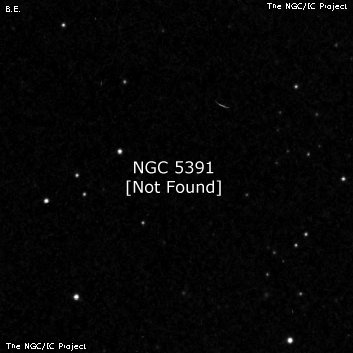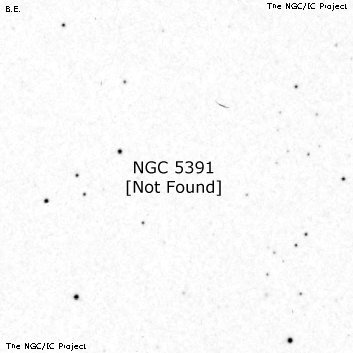NGC/IC Project Restoration Effort
(This is a very very beta version)
NGC5391


Basic Information
Location and Magnitude
Right Ascension: 13:57:36.5
Declination: +46:19:26
Constellation: CVN
Visual Magnitude:
Historic Information
Discoverer: Swift L.
Year of discovery: 1884
Discovery aperture: 16.0
Observational
Summary description: F, vS, * close
Sub-type: NF
Corwin's Notes
=====
NGC 5391 is probably not MCG +08-25-054 though taken as such by RNGC and
Wolfgang Steinicke. While it is somewhat brighter (B = 16.4, V = 15.4, and
R = 14.8) than my first choice, its position is off Swift's by 32 seconds in
RA and 3.6 arcminutes in Dec. Furthermore, there is no star "very close" to
the galaxy as Swift notes in his description.
Instead, the object he saw may be 2MASX J13574275+4628099 8.7 arcminutes north
of Swift's position. That galaxy does have a star "very close". Given that a
simple 10 arcminute correction to Swift's original position also puts the
galaxy well within Swift's nominal errors (2-3 arcminutes, exclusive of
blunders) of his position, and the fit to at least part of the description,
this is at least a reasonable candidate to consider.
I do have some lingering doubt. Swift's full description from his first paper
reads, "F, vS; to nu. * v close." While I presume that "to nu." means
something like, "brighter in the middle to a nucleus" -- which would indeed be
appropriate for the galaxy -- Swift's brightness estimate is several steps
brighter than I would expect for this galaxy. The SDSS magnitudes convert to
B = 16.8, V = 15.7, and R = 14.9. Swift would normally describe a galaxy this
faint as "eeF" or even "eeeF", if he could see it at all. In addition, there
are several brighter galaxies in the area including UGC 8876 and CGCG
246-029, as well as MCG +08-25-054 that Swift did not find. Furthermore, he
ran across NGC 5425 on the same night and called it "vvF"; its SDSS magnitudes
convert to B = 14.5, V = 13.7, and R = 13.2.
All of this leads me to put colons on the identification with the 2MASS
object. It is very faint for Swift to have found.



